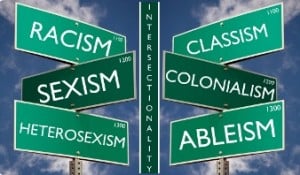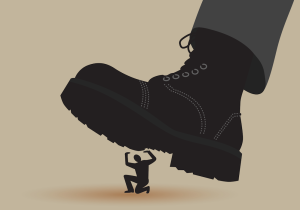
A person with their hands clasped together looks expectantly at someone with their hands on their hips, looking uncomfortable.
(Content warning: sexual violence, misogyny)
“I don’t want to encourage stereotypes, but it is kind of true.”
“We can’t just pretend men and women are the same.”
“It’s biology.”
A lot of people, feminists included, subscribe to this philosophy: Though we may exaggerate gender differences and should avoid making them prescriptive, cis men and women (non-binary people are usually excluded from such statements) do have some differences.
The types of differences they cite might include “Men are more interested in sex” or “Women are more emotional.”
Sometimes, the language gets so nuanced that it almost sounds like they’ve come up with something new: “Society says masculinity means being aggressive, but it actually means being assertive” (as if there’s a masculinity independent of society).
It’s hard to argue with these assertions because the stereotypes can seem harmless on the surface. After all, we can say some women are more sexual or more emotional than other women without insulting either group of women.
So why would it be different when we’re talking about men vs. women?
Well, first of all, whenever we talk about men vs. women, we exclude non-binary people. We also often exclude trans and intersex people, since these beliefs tend to be based on the false assumption that our biology determines our gender. (In reality, science shows that neither sex nor gender is binary).
Secondly, stereotypes about men and women stem from and reinforce a hierarchy that not only keeps men in power, but also justifies sexual assault and harassment. There’s a lot to be said about the first function, but I’m going to address the second (which also serves to keep men in power).
If you look around at all the ways society excuses men guilty of sexual assault, dismisses the need for consent, and blames victims, these stereotypes are evoked time and time again.
Here are some of the most prominent ones and how they’re used.
1. ‘Men’s Bodies Are for Action, While Women’s Are for Decoration’
One common form of benevolent sexism is to gush about how beautiful women are. Often, the binary view is that women’s bodies are delicate and aesthetically pleasing, while men’s are strong, capable, and useful.
First of all, talking about “women’s bodies” and “men’s bodies” is incredibly exclusionary toward not only intersex, trans, and gender non-conforming people, but also cis men and women who don’t have culturally idealized bodies.
When people make gendered generalizations about bodies, they are almost always referring to white, cis, strong, fit male bodies and white, cis, curvaceous (but thin) female ones. And when we actually manage to include non-binary bodies, we still tend to picture them as – you guessed it – white and thin!
Secondly, this encourages a disempowering stereotype that it’s men’s job to go out and get things done and women’s to sit there and look pretty – that men are active and women are passive.
And finally, it makes men full human beings, while women are only objects to be looked at.
You can see this in people’s language: In one episode of Seinfeld, Elaine tells George, “The female body is a […] work of art. The male body is utilitarian. It’s for gettin’ around, like a Jeep.”
This implies that men’s bodies are to be enjoyed by the men in them, while women’s bodies are to be enjoyed by outside observers. We are basically taught we exist for other people.
Overemphasis on how one’s body is perceived externally, rather than how it feels to be in it, is one defining aspect of objectification.
The notion that men’s bodies are made to act and women’s are made to be viewed or otherwise acted upon also encourages objectification, because an object is precisely something that is solely acted upon.
And if your body is just an object to be acted upon, it’s impossible to rape it, since it’s not capable of consensual sex anyway.
2. ‘Men Want, While Women Want to Be Wanted’
Madame de Staël famously said, “The desire of the man is for the woman, but the desire of the woman is for the desire of the man.”
In other words, men feel attraction, whereas women just want to be attractive.
In addition to being heteronormative, this objectifies women.
It denies women the right to their own internal, subjective feelings and defines them in relation to others once again. Their sexuality literally doesn’t exist without someone else’s (in this hetero- and cisnormative view) men’s.
The belief that men desire women while women just want to be pursued also encourages rape culture by implying that the only way to get a woman to sleep with you is to pressure her.
If women aren’t interested, there’s no point in waiting for them to want you before making a move. And if all they really want is just to be desired, then by expressing your desire toward them when they have no desire for you, you’re only giving them what they want.
The sentence “I don’t want that” is meaningless if women don’t want anything anyway, except for men to do what they want.
The pressure for men to pursue women and the belief that women shouldn’t pursue lead men to conclude that if a woman expresses disinterest, it doesn’t mean anything, because she’s “just being a woman.”
It also leads them to feel that if they fail at “convincing” a woman to sleep with them, they are lesser people, because getting past women’s defenses is supposedly their job.
The notion that sex results from men pursuing what they want and women caving makes consent impossible. Consent should be enthusiastic, which means that all parties involved want to have sex.
And to willingly engage in sex, your own desires and boundaries – not just someone else’s desire – must be respected.
3. ‘Men Want Sex While Women Want Love’
The belief that men are more interested in sex while women are more interested in love has spawned the theory that women “allow” sex in exchange for love, and men begrudgingly offer love in exchange for sex.
But if you’re sleeping with someone because you think that’s the only way to get what you need, you’re not really consenting.
Telling someone you won’t love them or provide for them or care for them if they don’t have sex with you is sexually coercive.
And while not all women are hearing this directly from their partners, women who get the message from society that they must provide sex in order to be loved are also being subtly coerced.
The notion that men are always after sex and don’t have any emotions implicated in sex also functions to justify sexual assault. Rape gets read as part of men’s essential nature when we believe their primary goal in life is to “spread their seed.” (Ew.)
And viewing women as less sexual – reducing their sexualities to the desire to be wanted – undermines their ability to give enthusiastic consent.
After all, what does this view mean for a woman who’s not sexually attracted to a man who wants to have sex with her? Or for an asexual woman who’s not interested in sex at all? Or for a non-binary woman who’s aromantic (that is to say, doesn’t feel romantic attraction)?
It means all of their needs, desires, and boundaries are disregarded.
According to the popular view of women as less sexual and more interested in love, the most consent women can really give is, “Okay.”
But affirmative consent requires a “Yes!”
4. ‘Men Are Aggressive While Women Are Gentle’
This is another example of benevolent sexism. Many people would rather be around a gentle person than an aggressive person, right?
However, women who are aggressive (or merely assertive) are punished more than men, and this dichotomy gets used to justify men’s aggression.
When men act violently toward women or one another, people rush to say that “boys will be boys.” Yet when women act remotely violently, even in self-defense, they’re demonized.
This happened when Gigi Hadid was criticized by various media outlets for elbowing a man who grabbed her out of nowhere and picked her up. Meanwhile, he was deemed a mere “fan” in these same headlines.
Whether it’s grabbing someone, verbally harassing them, or raping them, men are excused when they commit crimes because it’s supposedly just in their nature – they can’t help themselves.
When we believe men can’t help themselves, the blame gets shifted from perpetrators to victims, and women and gender minorities become responsible for doing, saying, and wearing the “wrong” things instead of men being responsible for respecting others.
***
These are just a few ways gender stereotypes can be far more harmful than they seem. And it’s not accidental that they operate this way.
Our popular notions about men and women don’t just happen to coincide with rape culture. These beliefs are encouraged and actively employed to perpetuate rape culture.
Men aren’t naturally more aggressive or more sexual. They’ve been trained to be this way by a male-supremacist system that keeps women in a subordinate position through violence – and that very training fuels this system.
Our ideas about beauty are not based on some objective, mathematical truth. The notion that men are to look and women are to be looked at isn’t based on the perception that women are more beautiful.
It’s the other way around: Our perception is based on that false notion.
Rape culture is a culture that teaches us that men naturally rape and women are asking to be raped. Given how twisted that belief is, it’s no surprise that a huge web of effed-up messages goes into creating it.
We can’t fix rape culture just by issuing harsher sentences toward rapists or telling people not to be raped – or even by telling people not to rape. We have to get to the root of all the beliefs that makes rape seem permissible.
And even if we think we’re just being realistic when we endorse them, a lot of the stereotypes we promote on a daily basis make up those roots.
[do_widget id=’text-101′]
Suzannah Weiss is a Contributing Writer for Everyday Feminism. She is a New York-based writer whose work has appeared in The Washington Post, Salon, Seventeen, Buzzfeed, The Huffington Post, Bustle, and more. She holds degrees in Gender and Sexuality Studies, Modern Culture and Media, and Cognitive Neuroscience from Brown University. You can follow her on Twitter @suzannahweiss. Read her articles here.
Search our 3000+ articles!
Read our articles about:
Our online racial justice training
Used by hundreds of universities, non-profits, and businesses.
Click to learn more




















